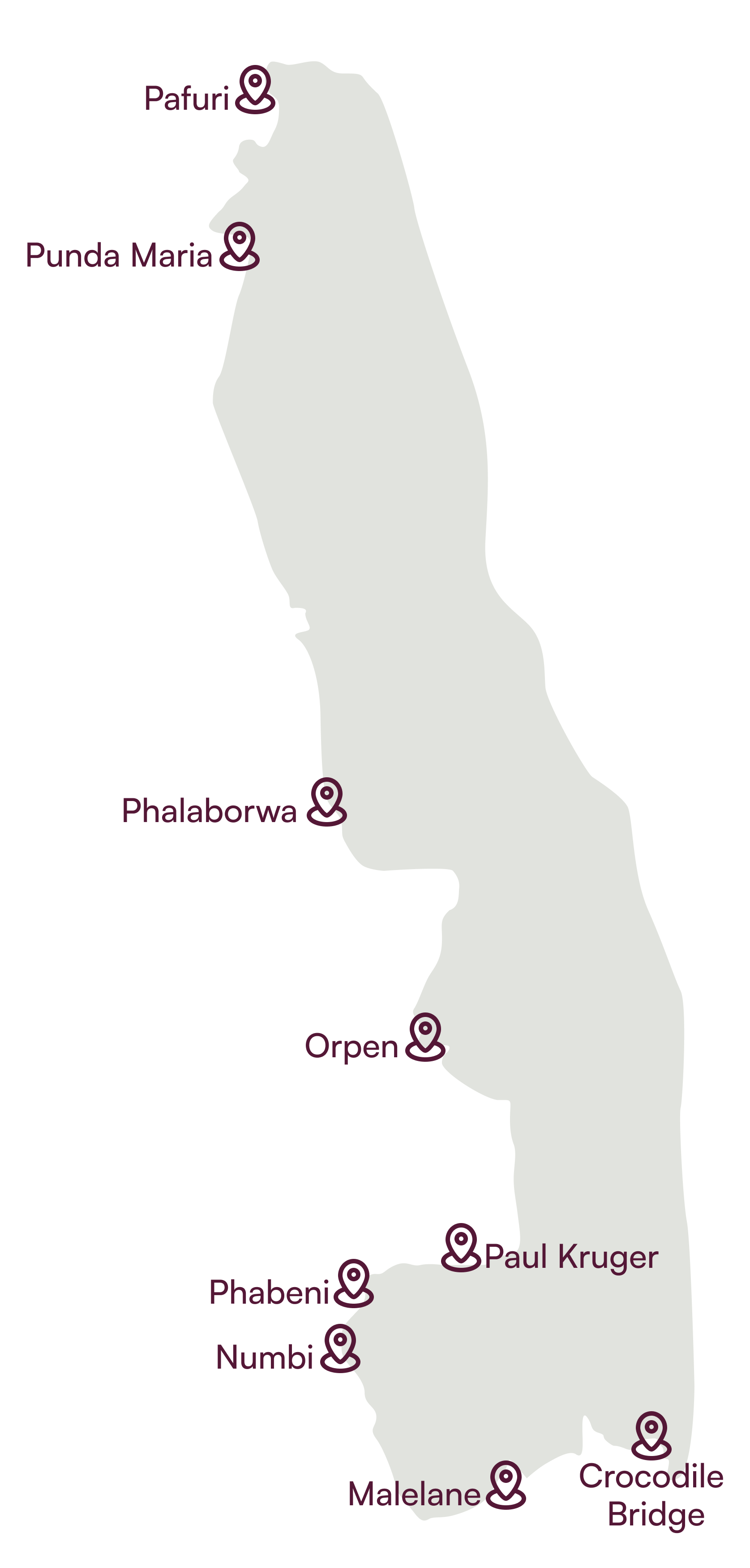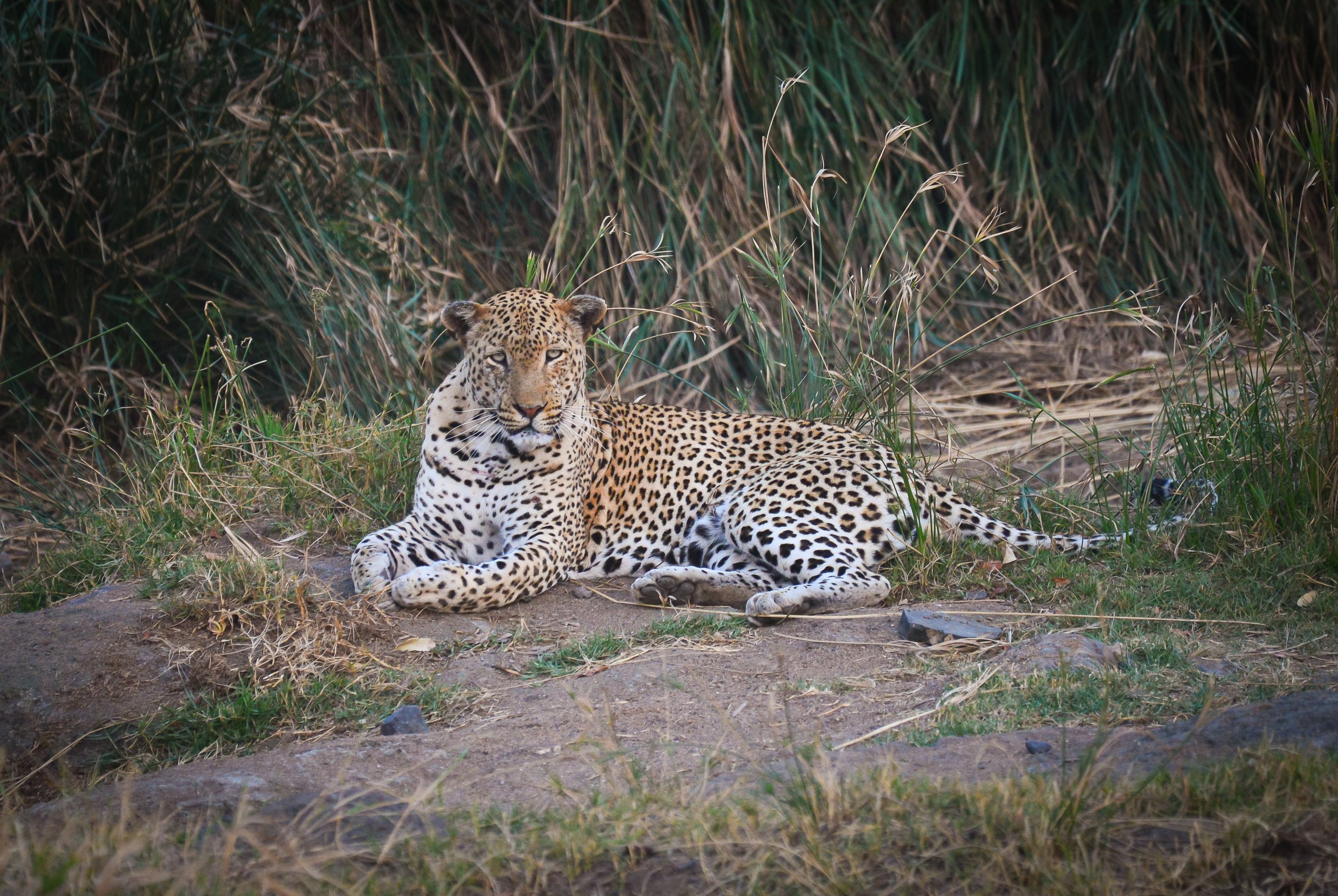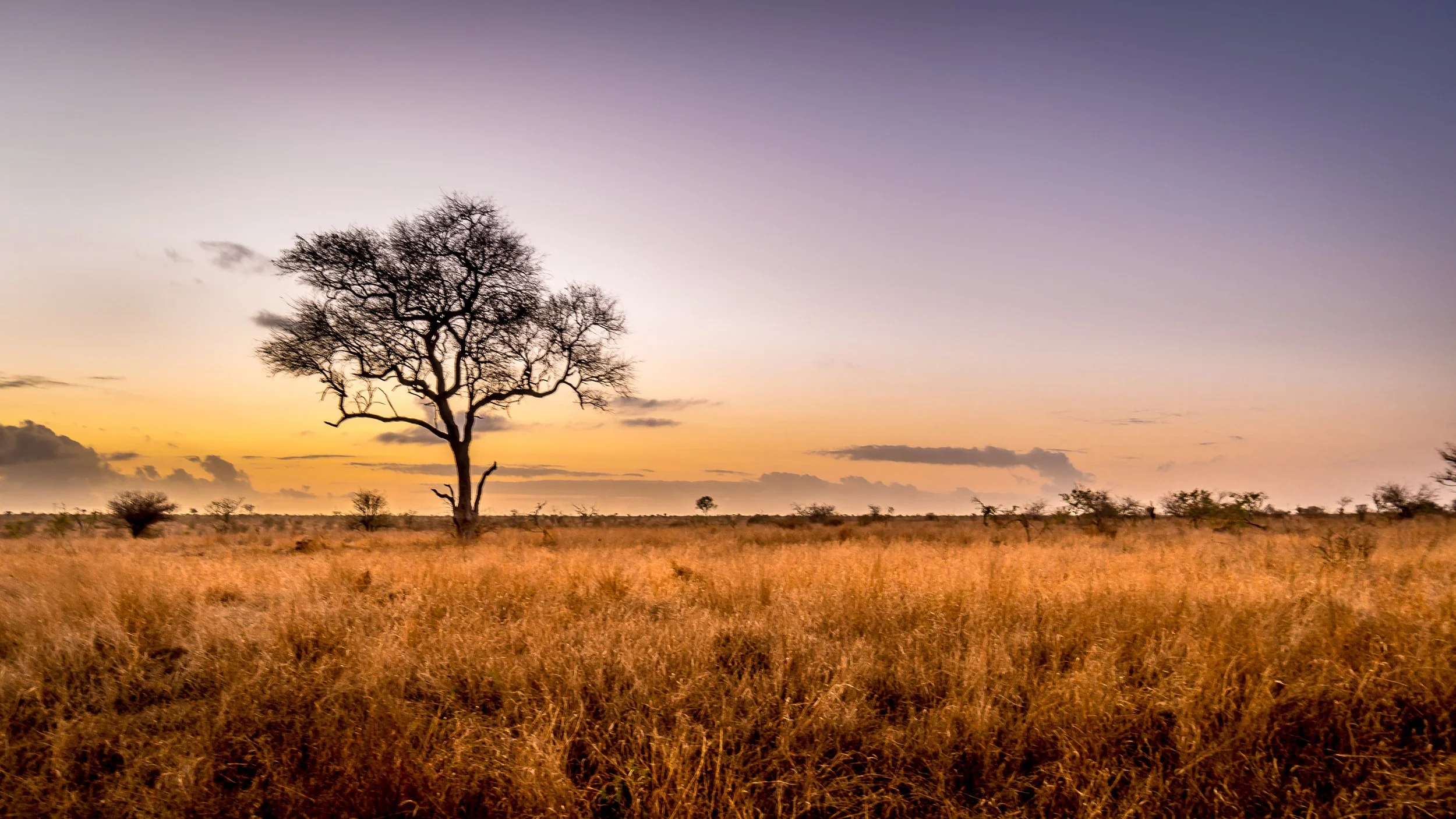A Complete Guide to Kruger National Park
Written by Zeldi Smulders
Kruger National Park is South Africa’s largest - and arguably most-loved - national park and forms part of the extensive South African National Parks (SANParks) group. The park was founded by former South African president Paul Kruger after he became aware of the damage caused by hunting in the area and realised that the Lowveld wildlife need to be protected. However, it was only named after him in 1926 when the Sabie Game Reserve and adjacent Shingwedzi Game Reserve were combined. The park is famous for its incredibly varied landscapes, diversity of wildlife and Big 5 sightings, and deservingly so. In this Kruger National Park guide, you will find out all you need to know about this famous South African site so that you can start planning the ultimate safari getaway.
Location
Located in the Limpopo and Mpumalanga provinces of South Africa, Kruger National Park stretches 352 kilometres, from north to south, along the Mozambique border. The environment is generally flat with a few hills and includes areas of open veld and dense bush. As you arrive, you find yourself surrounded by various trees like the baobab, fever tree, knob thorn, marula, and mopane trees. The Kruger Private Game Reserves of the Greater Kruger area neighbour the national park with an unfenced western boundary that extends the ecosystem and allows the animals to wander freely.
How to get there
With a high probability of landing in Johannesburg, you will drive about 430 km to Kruger National Park, which is about a 5-hour drive, depending on where you choose to stay or which gate you enter. If you prefer not to drive there, other main airports that you can fly to include Phalaborwa Airport in the north, Hoedspruit Eastgate Airport in the central area, and Kruger Mpumalanga International Airport (KMI) in Nelspruit in the south. After you land, you’ll get a transfer to your lodge.
Kruger Gates
As Kruger National Park is about 360 km long and 90 km wide, there are many entry points to choose from. Note that the Malelane Gate in the southern region is the most convenient entrance if you’re coming from Johannesburg or KwaZulu-Natal. The national access roads to the nine entrance gates are tarred, making it very convenient to reach. Here are the nine entrance gates, categorised according to their location:
Northern Gates
-Pafuri Entrance Gate
-Punda Maria Entrance Gate
Central Gates
-Orpen Entrance Gate
-Phalaborwa Entrance Gate
Southern Gates
-Malelane Entrance Gate
-Crocodile Bridge Entrance Gate
-Numbi Entrance Gate
-Paul Kruger Entrance Gate
-Phabeni Gate
Entrance Gates Opening Times
October - March: 05:30
April - September: 06:00
Opening times vary based on the season. Closing time can be between 17:30 and 18:30, also depending on the season. Following the rules of the park and surrounding reserves is for your own safety. Consult the Kruger Park gate times when planning your trip and look out for the camp gate opening and closing times if relevant.
Conservation Fees
Visitors to Kruger National Park pay a daily fee to help conserve the park’s natural heritage. There is a standard fee for international visitors, while South African citizens and residents with an ID, as well as SADC Nationals with a passport, pay different amounts. Children also have a lower fee. See the latest info on the SANParks Kruger conservation fees page.
Best time to go
In the Kruger area, each season has something for everyone to enjoy. The best time for wildlife viewing is in the dry winter months between May and August, continuing to the warmer and more humid end-of-winter months of September and October. During this time, the vegetation is thinner and due to the lack of rainfall, the animals congregate at waterholes, making them easier to spot. The winter months have pleasantly warm temperatures during the day with cooler nights.
The rainy summer months between November and April – peaking in January and February – is the green season. This is when you will see plenty of newborn animals as well as predator activity. Travellers have the advantage of fantastic birding and photography opportunities, but may face a malaria risk between October and May. Consult your doctor before visiting and ask about antimalarial medication use.
What to do
Main attractions
Kruger Park is not only home to incredible wildlife but is also filled with history and culture. You can choose to visit archaeological sites like Masorini and Thulamela, the Letaba Elephant Museum or the Albasini Ruins. Although, the wildlife remain the main stars of the show.
Day visitors are welcome, and all the main rest camps have day visitor areas where you can ask for more information.
Activities
Experience the guided Wilderness Trails
Use all your senses and explore the bush on foot to seek out the Little 5 and other significant fauna and flora that are best experienced up close on a guided tour.
Go on a picnic
Kruger National Park has various picnic sites, all with toilets and barbecue facilities. Some also include tuck shops where you can buy snacks, soft drinks and wood.
Try mountain biking
Cycle in the unspoilt wilderness during the morning or afternoon, accompanied by expert field guides. Full-day trails are only recommended for experienced cyclists.
Nearby sites
If you find yourself in the southern part of Kruger in Mpumalanga, you can explore one of the most scenic parts of South Africa by following the Panorama Route and stopping to admire Blyde River Canyon, the third largest canyon in the world. In Limpopo, the Waterberg Biosphere Reserve, a UNESCO conservation project, will spoil you with rich biodiversity encompassing popular safari mammals amongst rare species, set in one of the most significant San rock art areas in South Africa.
Wildlife & Safari
A Kruger National Park safari is undeniably special, thanks to its varied landscapes that attract a variety of wildlife, making it an unforgettable safari experience. It also offers budget-friendly safari experiences with the addition of luxury options in the surrounding area.
With thrilling game drives, you can venture out to seek the Big 5. You don’t need a 4x4 and self-driving is made possible with a terrific road network consisting of tarred main roads and other less crowded, high-quality gravel roads. SANParks also offers morning and afternoon game drives from each of the camps and entrance gates. Although there are some limitations when it comes to more exclusive safari activities, you can visit the surrounding private game reserves to enjoy the likes of night drives, off-road excursions and hot air balloon rides.
In Kruger South, you can come across the endangered African wild dog and the white rhino, while southwestern Kruger is the only part where the grey rhebok is found. The southern part of the park has sweet grass attracting lots of grazers and this is also an ideal area to search for some of the Kruger's rarest antelope. Visitors can look out for riverine bird species like the Purple-crested Turaco, African Green Pigeon, and African Fish Eagle.
Kruger Central has large numbers of predators like hyenas, leopards and cheetahs drawn to the area by the abundant antelope, giraffe, zebra and wildebeest which are in turn attracted to the sweet grass. This long list of predators also includes 60 prides of lions that call it home. In Northern Kruger, there are large herds of elephants, buffalos, impalas and kudus and it is also a great area for birding. There have been over 500 bird species identified at Kruger National Park, including the Big 6 birds (Kori Bustard, Martial Eagle, Lappet-faced Vulture, Pel's Fishing Owl, Saddle-billed Stork, and Southern Ground Hornbill)!
Where to stay
Basic
AfriCamps at Hoedspruit
Reconnect with nature in this truly idyllic stay found in the heart of the South African safari region. Ideally located on the embankment of a catch-and-release fishing dam, this spot caters for the whole family. From the wood-fired hot tub to the braai area with a view, there is something for everyone. Magnificent surroundings will draw you to landscapes like the Panorama Route, Kruger National Park, and the Blyde River Canyon.
Bushbaby Valley Lodge
Bushbaby Valley Lodge offers splendid self-catering and bed and breakfast options with a choice of 7 units. Overlooking the beautiful Sabie Valley bush, the lodge was named after the adorable nocturnal animals found on the grounds. When guests are done chilling in the swimming pool, they can take a relatively short drive to top Lowveld attractions like the famous Kruger National Park and the Blyde River Canyon.
AfriCamps at Mackers
Immerse yourself in the thriving Lowveld, while recharging on the banks of the Sabie River. This glamping getaway is ideal for any nature enthusiast or anyone who wants to witness South African wildlife. Long days can be concluded with a dip in the infinity pool. Neighboured by the Kruger National Park and many other must-see attractions, this hidden gem meets the requirements of a trip that won’t easily escape your memory.
Mid-level
Abangane Guest Lodge
Abangane Guest Lodge offers visitors a light-footed and exclusive stay with spectacular panoramic views of the bushveld bordered by mountains. At Abangane guests can take a dip in the infinity pool that surveys the lush valley or relax under the canopy of the bright flamboyant tree after a long day. Adventure seekers can go white water rafting on the Sabie River and Big Game enthusiasts can pop over to Kruger National Park, with Phabeni Gate only 15min away by car.
Kingfisher Creek Lodge
Located in the 400 ha Guernsey Private Nature Reserve, just a stone's throw away from the Orpen Gate of the Kruger National Park, Kingfisher Creek Lodge offers the perfect balance of natural tranquillity and safari excitement. The lodge boasts intimate luxury tented rooms, self-catering options and grassy plains populated by game. Guests can take advantage of their proximity to the incredible Blyde River Canyon by hiking the panoramic route or go on a guided bush walk around the reserve.
Ukuthula Bush Lodge
This intimate lodge sits in the Hoedspruit Wildlife estate, just a short distance from the Orpen Gate of the world-famous Kruger National Park. Guests can enjoy free roam of the estate, which is populated by plains game, an abundance of birdlife and many reptile species that often wander right up to the lodge. Adventure seekers can also venture to Hoedspruit nearby and book an incredible hot air balloon safari.
Fancy
Simbavati River Lodge
Located on Timbavati Private Game Reserve, Simbavati River Lodge promises an unforgettable safari getaway for couples and families alike with a choice of secluded suites, family-friendly chalets, and luxury tented accommodation. The beautiful river setting complements the traditional safari decor, and the subtle contemporary features enhanced by ample amenities give the ultimate experience of luxury. One of the clear favourites of this stay is the dining deck with a flood-lit waterhole below it, frequented by herds of elephants.
Tintswalo Safari Lodge
Tucked away in the 24000-ha Manyeleti Nature Reserve, Tintswalo Safari Lodge offers the perfect getaway for travellers looking for the ultimate game viewing experience. Home to the Big 5, and the Magnificent 7 (a list that includes cheetah and wild dog), Manyeleti Nature Reserve shares its unfenced borders with the famous Kruger National Park, Sabi Sands and Timbavati Game Reserves. Being located in such a pristine wilderness, it makes sense that Tintswalo Safari Lodge’s roots run deep with its conservation efforts.
Singita Boulders Lodge
Blending in seamlessly with its surroundings on the banks of the Sand River, the interiors of Boulders Lodge echo the soothing shapes of the stones found along the river nearby. Airy interiors spill out onto wooden decks shaded by bright green foliage, perfect for much-needed unwinding. The lodge’s 12 glass-fronted suites invite nature inside while allowing guests the utmost privacy. Boulders Lodge, as part of the Singita brand, is committed to the protection of the environment and the empowerment of local communities.
How to include Kruger National Park in your sustainable South African adventure
Kruger National Park is one of the top attractions in South Africa and a minimum stay of 3 days is recommended, in which case you’ll still probably have to choose between one of the vast regions. A week will be more comfortable if you choose to travel between the southern, central and northern sections. A Kruger adventure can also be combined with the Panorama Route, which many visitors prefer to do because of its close proximity. If you want to see more of South Africa’s stunning biodiversity, you can start or end your trip in the Western Cape area for a beach and bush combo.
Take a look at these trips to inspire your next adventure:
13 Days of Luxury Kruger & Garden Route Discoveries
Seek out the Kruger’s Big 5 and stumble upon charming seaside towns with stunning Garden Route views.
South Africa’s Dream List: 18-Day Extensive Sun, Sea & Safari
Discover the Kruger, Garden Route, Winelands, Cape Town and many more of South Africa’s unforgettable highlights.
Bargain Beach to Bush: South Africa’s Garden Route & Kruger
Get a cost-effective kick out of Blue Flag beaches, Garden Route gems, and Kruger game drives.
Insider tips
Pack long-sleeved shirts and long pants for the evenings to protect yourself from mosquitoes and keep warm at the same time.
If you are in need of cash, there is an ATM at Skukuza and Letaba and a bank at Skukuza, open Monday to Friday and Saturday morning.
Petrol and diesel are available at all major camps. The fuel stations accept VISA/MasterCard or cash.
Kruger is a memorable safari destination that deserves a place on your bucket list. Tick off South African sunsets, unique safari stays, and Big 5 sightings by booking a sustainable trip to the Kruger with Viatu.








